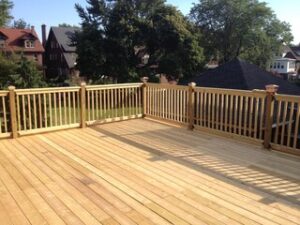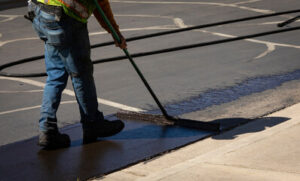Deck installation is a large-scale project that requires planning and coordination. Homeowners should choose a contractor with experience and expertise to ensure a safe, functional deck for entertaining or relaxing.

Joists are installed perpendicular to the house and are supported by a ledger board on the house side and rim joists on the outside. The rim joists are topped with low-maintenance post wraps to help them last longer and achieve a specific aesthetic. Contact Deck Builders Baltimore County for professional help.
A deck is an outdoor living space that is a perfect place to relax, unwind, and enjoy the scenery. However, a deck must be built properly to ensure that it’s safe and durable. This includes proper footings, framing, and hardware. It is also important to have a design plan that is approved by a structural engineer. The structural engineer will evaluate the deck’s load-bearing capacities and foundation depth, helping to prevent future problems like sagging or collapse.
Before beginning the actual building of your deck, it’s a good idea to create a layout that will help guide the construction process. This will help make the project run smoothly and avoid mistakes that can cost you time, money, or even the entire deck. A layout plan will help you determine the size and location of your decking, stairs, and railings. It will also help you select the right fasteners and decking materials for your project.
Decks need to be framed using lumber that can withstand heavy loads and lateral forces from wind, snow, and rain. In most cases, joists will be installed perpendicular to the house with a ledger board on one side and a beam on the other. The outer joists, which are often referred to as rim or band joists, are supported by the ledger and sometimes by additional joists.
Joists must be anchored to the house with deck bolts or screws, and flashing should be installed above the ledger board to prevent water from entering between the house and the deck. It’s also important to use deck joist hangers to securely fasten the joists to a ledger board, beam, or rim board.
Framing
Getting the deck framing right is essential to building a solid and durable structure that will last as long as the house it hangs from. Smart details for ledgers, posts and joists make the difference between an ordinary deck and one that can stand up to abrasion, moisture, and the occasional winter heave.
Using an appropriate-sized drill bit for the fastener size, predrill holes in each deck board location. This will prevent the wood from splitting as you drive the fastener into place. For a cleaner look, use stainless steel fasteners when installing deck boards. Fasteners made from anything else will leave unattractive blemishes and can cause the wood to break down prematurely.
To keep the joists and beams properly aligned, use a framing square and 4′ level to check the alignment of each corner. This highly accurate method leaves little room for error and helps ensure a sturdy deck frame.
Rim joists (also called end joists) and beams are the main load-bearing components of your deck. They’re located on both sides of the ledger and form a bridge between your house and your new deck.
For stability, the rim and beams need to be connected to each other with either joist hangers or diagonal bracing. Both methods increase the strength of your deck, reducing the chances of it shifting or swaying under stress.
For older houses with thick timber mudsills, Tom often uses lag screws to secure the 2x rim joists to the sill plate. In homes of more recent vintage, he uses joist hangers to connect the rim joists to the 2x ledger.
Posts
Posts stand under the deck beams and transfer the load of the structure to concrete footings sunk in the ground. Local building codes may dictate minimum post sizes and spacing to ensure safety. The height of the deck will also influence post size requirements, as larger posts can handle greater forces and leverage.
When installing a deck, you will need to determine the location of the posts and mark their locations on the deck frame. You will also need to dig or use post anchors to set the posts firmly in the ground. It’s important to accurately install the posts, because they will be the center of the structure and must be strong enough to support the weight of the deck boards.
The posts can be buried in the ground, or they can rise above the deck level. If you choose to bury the posts, it’s best to have them at least 6 inches below the frost line in your area. This will help prevent the posts from rotting over time. If you opt to raise the posts, it’s possible to use a post anchor system that will save you the work of digging a hole and pouring concrete.
You can also use a post bracket to connect the posts to the floor joists. This is a fast and economical method, but you must make sure the brackets are installed correctly. Use a level to check for plumb and predrill the holes for lag screws or nails.
Posts can be made of wood or a composite material that combines wood fibers with recycled plastics and other materials. These materials are weather and insect-resistant, don’t require staining or resealing and are available in a variety of styles and colors.
Boards
Many homeowners prefer natural wood decking for its warm good looks, cost effectiveness and the ease with which it can be stained or oiled to preserve its color and protect against weather damage. But, despite its relative durability, traditional wood requires a great deal of upkeep and deteriorates quickly in the sun. Alternatives such as capped composite or engineered wood can offer the beauty of real wood with far less maintenance.
When installing the decking boards, you should always pre drill each hole with a drill bit that matches the screw size. Failing to do so may cause the board to split and will lead to unattractive blemishes in the decking surface. Additionally, the use of fasteners made of anything other than 305 stainless steel will cause rust and corrosion which could ultimately weaken the decking.
After you’ve drilled each hole, insert the fastener. Typically you will insert the head of the screw so that it is flush with the surface of the decking. Then you will drive the screw down into the joist until it’s at least 1/4 in below the decking surface.
The last few boards you install can be fixed using a hidden fastener system. The spacer tabs on these systems fit into a groove in the decking boards to hide the screw heads from view. This is a good way to finish the deck if you ran out of decking or just didn’t have enough time to get to it.
A joist tape is also a smart idea to help with water resistance in your deck’s understructure. It will be installed across the joists and ledger board to protect against moisture and will prevent the deck from rot.
Railings
The railings are the final touch on a deck and come in many different designs to complement your home. They are also a safety feature as they prevent people from falling off the deck. For this reason, local building codes have strict rules about the height of a railing and how closely it should be spaced. At Archadeck, we only offer railing options that comply with these rules and will pass a building inspection.
Traditional Style: Wooden railings and balusters pair well with most home styles. They are available in a variety of species such as cedar and redwood, which each have their own defining color, natural resistance to rot, and unique look. We also carry low maintenance composite railings that can be stained or painted to match your deck.
Modern Style: Metal and cable rails are a newer design that pairs nicely with contemporary homes. They have a clean and sleek look, with minimal visual obstruction that allows the view to remain open. They are available in a wide range of colors and can be combined with a wooden or composite deck.
Consider accessibility: If a family member has mobility issues, then a handrail should be part of the deck design. Whether it’s made of wood, composite, aluminum, iron, or glass, a good handrail can provide stability for those who need assistance getting around the deck.
For this reason, it is important to choose a railing design that meets ADA guidelines for handrail height and grip size. Our professionals are here to help you navigate the various design and material choices that can satisfy your specific needs. We can also advise you on how to meet local building code requirements.


